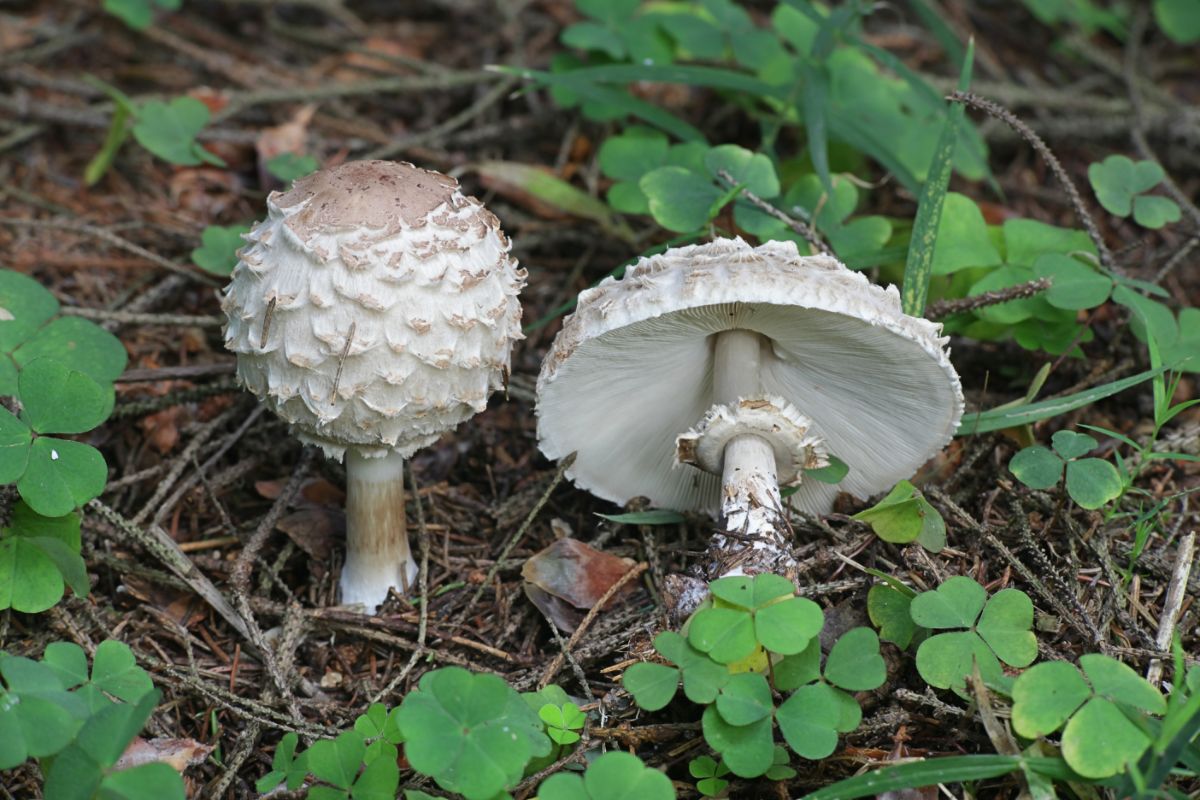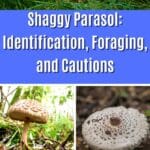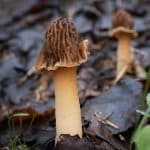Shaggy Parasols are an edible mushroom with a flavor similar to button mushrooms but much, much better. They also have an excellent, dense texture. However, this edible mushroom comes with one very troublesome lookalike, along with a lookalike that is even more valued than it. This makes foraging the shaggy parasol slightly tricky; imagine having two lookalikes, one fantastic, one gut-destroying. This is not a mushroom for the beginner forager, sadly.

Don’t get the wrong idea – Shaggy parasol identification isn’t difficult. But, you do have to be paying very close attention to details, understand the different parts of mushroom identification, and be more cautious than impulsive. For mushrooms like these, I always recommend passing them up the first few (or 50) times you find them and just focus on identifying, not eating.

Jump to:
Shaggy Mushrooms and Parasols, What Is The Difference?
There are several edible mushrooms with very similar common names: Shaggy Parasols (discussed here), Parasols, False Parasols (the vomiter), and Shaggy Manes. They are not the same mushroom! Shaggy parasols and parasol mushrooms are very similar in appearance. In fact, not that long ago, they were thought to be in the same genus. It’s pretty easy to get these two confused.
On the other hand, Shaggy Manes are only superficially similar to parasols and shaggy parasols. They’re easy to differentiate once you know what to look for. However, due to their common names, shaggy manes and shaggy parasols often get confused or mixed up as to which is which.
False parasols, unfortunately, also look incredibly similar to shaggy parasols. This is the problematic species, as it will make you quite ill. It’s not deadly, but you might wish you were dead after eating it — severe gastric upset is just one of the joyous side effects of eating this mushroom.

All About Shaggy Parasols
The name shaggy parasol actually refers to three very similar and closely related mushroom species:
- Chlorophyllum rhacodes (or racodes; the man who originally named the species translated the Greek word for “piece of cloth” incorrectly.) – Widespread in North America.
- Chlorophyllum olivieri – Pacific Northwest Species
- Chlorophyllum brunneum – West Coast species with rare occurrences on the east coast.
All three of these species occur in North America, as well as Europe and southern Africa. These species used to all be under the same name, Macrolepiota rhacodes. Then, in 2002, DNA analysis done by mycologist Elsa Vellinga separated the species and determined that they were closer in relation to Chlorophyllum than Macrolepiota. Yeah, fungi taxonomy gets really crazy sometimes.
In guidebooks, you still may find this species listed under Macrolepiota or just Lepiota.

Shaggy Parasol Identification
Season
Spring through fall, but more common in fall.
Habitat
These mushrooms are most common in open fields and meadows, lawns, and pastures. They’re also found in greenhouses, wastelands, and gardens. They grow singularly but are often found in large numbers growing near each other. Shaggy parasols are known to grow in fairy rings or dense troops. They tend to be more common in areas with conifers, spruces in particular.
Chlorophyllum rhachodes is widespread across North America, but more common east of the Rocky Mountains. Chlorophyllum brunneum is found on the west coast of North America. It may occur on the east coast, but it is scarce there. And lastly, Chlorophyllum olivieri is only in the Pacific Northwest.

Identification
Cap
This is a large-capped mushroom that truly stands out wherever it grows. Caps average 2.5-8 inches across and are covered in shaggy tattered white fibers with thick brown scales on top of them. The white hairy fibers cover the entire cap, like animal fur – it’s fluffy! Then, brown scales are scattered on top of the furriness, often in concentric zones but unevenly and sporadically.
While the average size of the cap is small dinner plate size, they can also get quite large — to full dinner plate size! This is one reason folks love foraging this mushroom; one shaggy parasol makes a meal!
In youth, the cap is ball-shaped, like someone plopped a golf ball on top of a tall stem. Or, like a large light brown lollipop. At this stage, the cap is covered by a thin brown skin (veil), which breaks apart as the mushroom grows to create thick scales. The cap’s edges are pretty tight around the stem at this point, and the gills are covered by brownish skin, a universal veil.
As the shaggy parasol matures, the cap opens up and spreads out like a flattish disk or open umbrella. At the very center of the cap, there is an upraised brown bump – this is the remnant of the brown skin that previously covered it.
The scales are also remnants of that skin, but they are broken up and scattered around – they are not uniform in size or thickness. The scales often look patterned, rippling out from the brown center like waves to create a rather decorative aspect. With age, the scales can fall off from heavy rains, but they rarely fall off entirely.

Gills
Shaggy parasol gills are white and close together. You can’t see the gills in the button stage because they are covered by a thin membrane called the universal veil. The gills tend to turn light brown when the mushroom is fully mature.
Stem
The stem is evenly formed with a bulbous base. It is a significant size, averaging 2-8 inches tall. Stems are white without patterning or decoration but may be brownish on the lower half. The stem will bruise brownish with handling, too.
On the upper part of the stem is a white skirt encircling it. This is a remnant of the brown skin (universal veil) that previously covered the mushroom. The top of this skirt is white, but the underside will have brown bits.
Flesh
When a shaggy parasol is cut, the white flesh turns pinky-orange or a saffron color, then turns rusty-red or maroon. This is especially apparent at the top of the stem.

Spore Print
White
On The Lookout
Keep an eye out in fields, meadows, and open green areas for a tall white and tan mushroom. If it’s there, it’s unlikely you’ll miss it!

Differentiating Between The Three Shaggy Parasols
Determining which shaggy parasol species you’ve found can be a little tricky. The principal determiner is location, but there are a few other telltale signs to figure out which one you’ve found.
- Chlorophyllum rhacodes – Fits the description above perfectly as the type species. Occurs across North America. The skirt around the stem is two-layered (think petticoats) and movable up and down the stem.
- Chlorophyllum brunneum – Occurs primarily on the west coast, with rare occurrences on the east coast. It has an abruptly bulbous stem and a single-layered stem skirt (think slip).
- Chlorophyllum oliverei – Occurs only in the Pacific Northwest (and Europe). It has a double-layered stem ring (like petticoats), just like C. rhacodes. The primary difference is the shagginess on the cap is more brown than white.

Shaggy Parasol Lookalikes
Parasol (Macrolepiota procera)
This parasol mushroom looks exceptionally similar to the shaggy parasol, with a few key differences. Thankfully, these differences are easy to distinguish to make a clear identification. The parasol has a decorated stem that looks quite a bit like snakeskin. The shaggy parasol stem is never decorated like that. Also, the parasol’s cap is less shaggy overall than the shaggy parasol.
The parasol is a highly valued edible mushroom, so if you do find this one, celebrate! However, make sure you identify it correctly, as well, since the false parasol is also similar and will make you quite ill.

False Parasol/Vomiter (Chlorophyllum molybdites)
This is the most challenging lookalike for the shaggy parasol. When young, they look incredibly similar. They both have shaggy caps, bare white stems, golf-ball-like caps, and a similar size. The only way to be absolutely certain you don’t have a false parasol is to do a spore print. False parasols have a greenish spore sprint, while shaggy parasol’s spore print is white.
Once they mature and open up their umbrella-like caps, it becomes easier to distinguish between them. The false parasol will have greenish-colored gills, while the shaggy parasol will have white gills. It’s still a good idea to do a spore print, just to be sure! The false parasol’s other common name, the vomiter, isn’t just for fun.
Learn more about the False Parasol here.

Shaggy Mane (Coprinus comatus)
When young, shaggy manes look slightly like shaggy parasols, but they’re not complicated lookalikes. Shaggy mane caps are elongated, not rounded. Sometimes when they’re very young, they’ll be a little round, but they quickly morph into their lanky appearance.
Shaggy manes usually grow in large groups, and they’ll be at different stages of maturity. A clear sign you’ve found shaggy manes is seeing some inky black rotted messes nearby – that’s what they turn into once past maturity. Shaggy manes are also an excellent edible if you find them in good condition, so harvest these if you see them. Just be sure to cook them up the same day so you don’t end up with a gross, melted, inky mess in your fridge!
Learn more with this in-depth identification and foraging guide for Shaggy Manes.

Cooking With Shaggy Parasols
Eating shaggy parasols should always be done with caution, especially if you’ve never had them. While you should always be conservative when trying new mushrooms, it is especially important with this one. And, it’s not because it might be the false parasol vomiter.
Shaggy parasols contain a number of toxins that cause a severe gastric upset when eaten raw. These toxins are neutralized upon cooking, but some individuals report that cooking isn’t enough and still experience issues. How widespread this problem isn’t known – this is hearsay from mushroom groups and forums, so it’s hard to know precisely the extent of the sensitivity with people. Or whether it’s a rumor based on one person’s reaction that has now taken on a life of its own.

On the other hand, folks have been eating shaggy parasols for centuries, at least. And there’s a reason for that – they’re delicious! Their flesh is dense and thick and holds up to cooking and frying.
Shaggy parasol mushrooms taste best when they’re younger. They have a mild, pleasant flavor, like a button mushroom but with more depth. The cap tastes better than the stem. In fact, many people toss out the stems because they’re tougher and less palatable. The stems are perfectly edible, though; just know they need a bit longer cooking than the cap.
Due to their considerable size, the caps are perfect for stuffing, frying, and grilling. Use them in any recipe with button or portobello mushrooms for an upgraded result.
Shaggy Parasol Mushroom Recipes
- Cornmeal Fried Shaggy Parasols
- Shaggy Parasol Stroganoff
- Stuffed Shaggy Parasol Mushrooms
- 3 Recipes: Shaggy Parasols with Noodles, Beef and Red Wine in a Clay Pot, Mushroom Potato Kugel
- Shaggy Parasol and Potato Soup

Common Questions About Shaggy Parasols
Is the Shaggy Parasol Mushroom Poisonous?
There is a lot of conflicting information online about whether this mushroom is safe to eat. The short answer is, no it is not poisonous at all — meaning, it will not kill you if you eat it.
It does contain toxins, though, that will cause severe gastric upset if the mushroom is eaten raw. Some people report the severe gastric upset even after it is cooked. However, there are no studies or even statistics on how common that is, or widespread.
So, it is up to you to decide whether to eat it or not. Many, many people eat and have been eating it for centuries, and it is unknown if any had issues with it. It didn’t stop anyone from consuming it previously.
Best practice is to eat a little bit, see how your body reacts, and go from there. It could be the next best mushroom in your foraging portfolio. You could regret ever hearing the mushroom even exists. Be smart, be mindful, be cautious.
What is the primary difference between parasol and shaggy parasol mushrooms?
The stems of shaggy parasols are bare (undecorated), while the stems of parasols are decorated with a brown and white pattern that kind of resembles snakeskin.









Cindy says
Is there somewhere I can send a picture of what I found in my pasture. I know it is a parasol, but can’t figure out if edible or not.
Jenny says
You can post images on our facebook group https://www.facebook.com/groups/340690111324762. Please be sure to read the featured post to make sure all the necessary info is included with the photos
Sahara says
Thank you for this information. I believe I have shaggy parasols growing in my chicken run. (Spore print is white). And I noticed a typo in the article. The caption on the photo at the bottom of the section entitled “Differentiating Between The Three Shaggy Parasols” refers to Shaggy Manes, and I think it is meant to say Shaggy Parasols.
Thanks for sharing your knowledge!
Jenny says
Thanks for the heads up on the typo! All the names must have been swimming in my head while writing LOL. Congrats on the find — they’re a delicious mushroom, just make sure you cook them up the same day they’re foraged